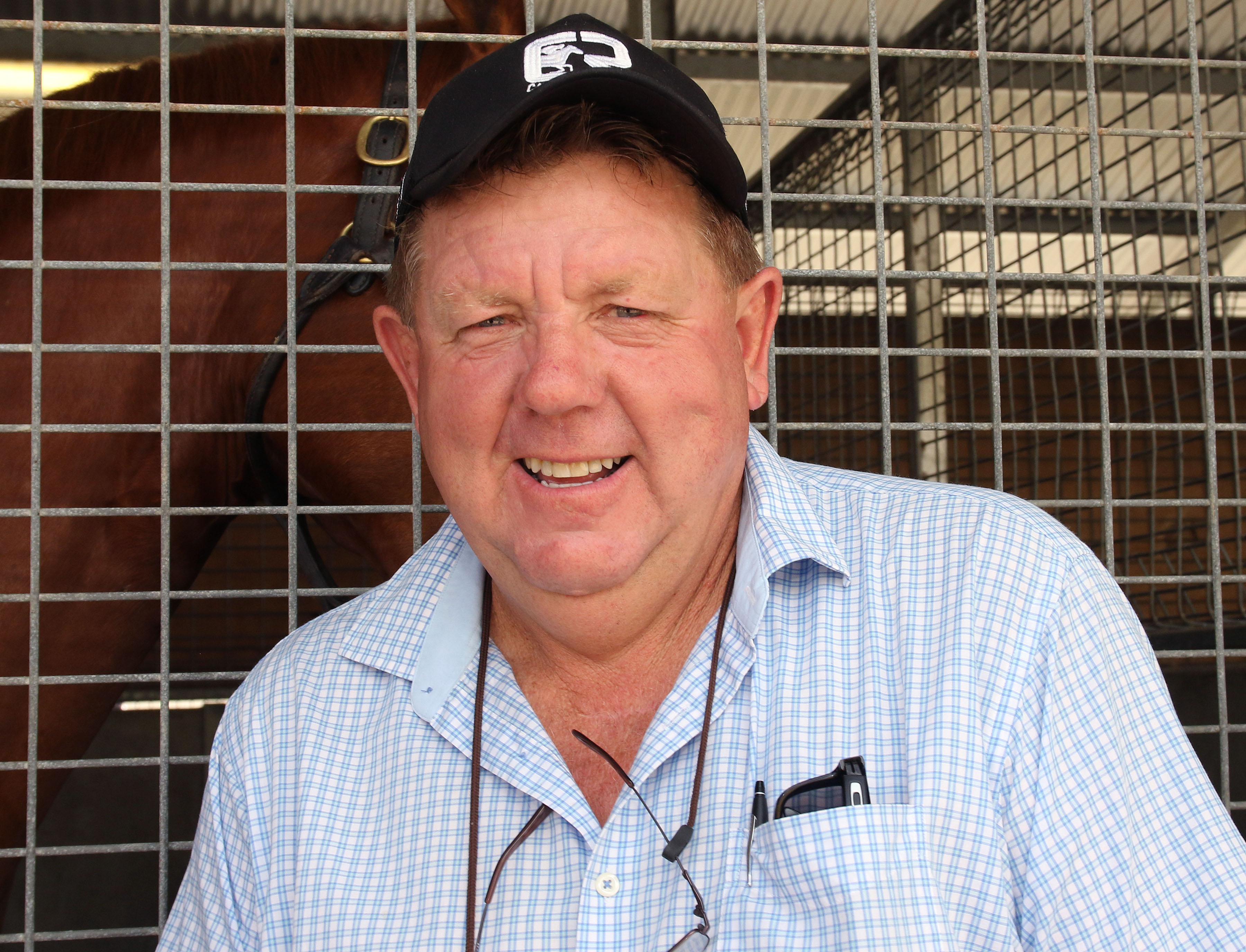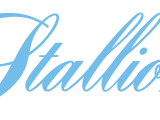
Since the advent of political correctness about 50 years ago much of the western world’s population seems to have been sapped of individual personality. This is particularly evident in the thoroughbred industry, which has been littered with characters through much of its 200 year-plus history in Australia. But one man who remains larger-than-life is Scone based trainer Brett Cavanough.
The 57-year-old, who established a world shearing record in his rough-and-tumble younger days, is regarded as being quite an identity wherever he goes. With his record of just on 900 winners at a winners-to-runners ratio of more than 15 per cent for prize winnings in excess of $14 million his story is inspirational.
Once a battler Brett’s recent record has attracted owners, such as Dynamic Syndications, who have in turn given him a better class of horse.
This group feature the Shamus Award mare It’s Me, who cost $65,000 at the Inglis Classic Sale and took her earnings to $816,700 in scoring a breathtaking fourth straight win in The Kosciuszko.
While It’s Me was on the sidelines recovering from a tendon injury suffered in The Kosciuszko Brett unearthed another potential super star in the Hinchinbrook colt Pinnacle Prince.
There are a number other promising types in the system – such as Fender, who won at his first four outings and attracted an offer of $1 million – so he can be confident and comfortable about his future.
As he looks back, after 23 years as a professional trainer, he regards early experiences with the legendary T.J.Smith, the extremely skilful Neville Begg and the topflight veterinarian John Peatfield as being invaluable. “They gave me a blend of experience that I’ve used since I began training. I was able to get a really good grounding from them, which I absorbed and stored away for use when I began training. I suppose I learned the hardness from T.J., the soft-touch with the fillies from Neville Begg and the mechanics of the horse from John Peatfield, which has stood by me right through.” So has his dedication, his ability to work hard seven days a week, the knowledge he has developed about racehorses and his professionalism.
“I have always gone hell-for-leather and worked hard from my shearing days and into the time I have been training. For a while I generally had older horses, the problem horses, but now I am getting well-bred horses that are brand new.
We have a barn full of them so the next two or three years are going to be interesting,” he said.
“Fortunately we’ve had a bit of success along the way and since we’ve settled in Scone it’s been really good. We’ve acquired a nice 65-acre irrigation farm with a beautiful, big home and my wife Lauren bought the Cellarbrations bottle shop in the town. It’s still hard work every day of the week but the rewards are good and it’s a lovely lifestyle so we are enjoying every minute of it.”
It was in his younger days that Brett’s flamboyant character began being defined. He was born in Brisbane but after being adopted by his grandparents Frank and Phoebe Cavanough he moved with them to their Booka Station in western Queensland. The property was not far from Roma, which is in the Maranoa Region over 450km from the State capital.
“I did my early schooling at Roma. Then I did a couple of years at Augathella, which is further out west, and then went back to Roma for years eight and nine. When I was old enough to ride my grandfather bought me a retired racehorse, which I had in the backyard. By the time I was twelve I was riding trackwork for my grandfather,” Brett said.
“We’d also go racing, mainly at Roma, and that’s when I became infected with the bug. Jim McCormack and Barry Baldwin had stables in Roma at that stage and they each had about 30 or 40 horses and rode their own work. As a young kid I worked for Jim McCormack until he was killed and then I went across to Barry.”
On finishing his schooling Brett said he had a “quick stint” working as a strapper at Eagle Farm before heading straight back to Roma and on to Charleville, which is about 730km from Brisbane.
It was while in Charleville that he first met Peter Moody, who was to achieve international fame as the trainer of the unbeaten champion Black Caviar. “I was probably 17 and Peter would have been about 11. My grandfather was instrumental in bringing up Peter and he is mentioned in the books written about Moody’s training career.”
Then when he was 18 or 19 Brett decided to venture to Sydney where he first gained experience with Tommy Smith, who won a record 33 Sydney training premierships. “I was about 70kg then and I rode track work for T.J. and did some breaking in for him. I also rode work and broke-in for Neville Begg and I met the veterinarian John Peatfield. I was very fortunate to have the chance to work for them because, as everyone in the business knows, they had a wealth of knowledge about racing and about horses,” Brett said.
After a few years in Sydney he “gypsied for a while” including working on oil rigs, which took him to the north of Western Australia where he met his wife Lauren, who was working on Yarraloola Station. “Lauren was doing the book keeping for the helicopter pilots on the property when I met her,” Brett said.
They have four children Jess, 23, Georgia, 22, Jack, 21, and Sam, 19.
Jack, who has joined up as a foreman and track rider for his father, gave the family a dreadful scare when he had a fall riding work in July and suffered bleeding on the brain. Being as resilient as his father he recovered quickly and is continuing on in the role.
Of the other Cavanough offspring Jessica is still deciding where she wants to head, Georgia is doing paramedic medicine at university, and Sam, who lives in Melbourne, is studying for law and commerce degrees.
“We had four children in five years during a time when I was deciding what to do. I think I was about 24 when a mate said ‘why don’t you have a crack at shearing’. I was strong and tough by then and at the peak of my powers”, said Brett. It was not long after going into his new calling, on a cold, wet day in September of 1997, that Brett became the first Australian to hold an official World Shearing Record at the renowned sheep-breeding Widgeiwa Station in the Riverina region of New South Wales. Including catching, dragging, gear changes and having drinks, he averaged shearing a sheep every 67.44 seconds for a grand total of 427 in eight hours to the cheers and amazement of everyone who crowded around to watch him in action.
“World records had been set in New Zealand and Wales but I was the first Aussie to establish a world record. It was hard back breaking work but something I am very proud of. I went full bore at the shearing for 12 or 13 years until we decided to settle in a little town called Tocumwal, where I continued shearing. A lovely border town, in the N.S.W. Riverina, Tocumwal is on the Murray River 270km north of Melbourne.”
It was at Tocumwal that Brett’s career as a trainer began. “One day I went to a property owned by a bloke named David Arnold. He had a few horses in the paddock and I picked a couple of them out without knowing their breeding.
One didn’t get to the races but the other one was a horse named Goquillo, who put me on the map.”
A gelding by Gopak (USA) from the Knightly Manner (USA) mare Petal Link he won 12 races in Brett’s care and was placed on another nine occasions. Goquillo registered his first win in a 1100m maiden at Seymour on January 7 of 2001. He won nine days later at Albury and taken to Queensland in the middle of the year he won successive races at Toowoomba on the Darling Downs. On January 20 of 2002 Goquillo notched up Brett’s first metropolitan victory when he took the VRC Ross Bradfield Handicap (1400m) at Flemington. Another memorable success came on December 6 of 2002 when Goquillo won the Murrumbidgee Turf Club’s Ted Ryder Cup (1600m) at Wagga.
“Guys like going to beaches and whatever with their horses but Tocumwal was an outstanding place to train. I had a sandhill to work on and a racetrack to gallop my horses on as well as the Murray River where I could walk my horses against the current. It was a no-brainer at the time because there weren’t many track riders about.”
As a result, before long, the horse numbers Brett had begun to outgrow the facilities at Tocumwal, even though he had built a 30-horse barn and had accommodation for 66 horses in training. Also in those years Peter Moody’s standing in the industry was on an upward spiral at Caulfield and he approached his old mate to break-in for him on a full-time basis.
“Lauren and I had four kids of school age and we were wondering what we should do and where we should go. We knew the schools in Albury were pretty good and one morning I rolled out of bed at about 3 o’clock. I drove the 140km or whatever it is to Albury and met a bloke, who had a 40 horse complex with a house in front of it. It was mickey mouse, ready to go. I asked him when I could lease the place and he said ‘tomorrow’ so I signed up the lease and started moving the horses in.”
“Over the next 12 months it just grew and grew and grew. Almost before I knew it I had probably 80 horses in work and I was breaking-in horses for Moody. Among them was the Bel Esprit filly who became Black Caviar. She went on to soar to world-wide acclaim by winning at each of her 25 starts, with 24 of them being in stakes races. Of those 12 of those were in Group 1s featuring the Ascot Diamond Jubilee Stakes (1200m) in 2007.”
“It is an honour to know I have broken-in a horse like Black Caviar. “I always thought she might be special but I can’t say I ever imagined she would turn out as great as she did,” Brett said.
By the time he was breaking in Black Caviar, who was foaled in 2006, Brett had won his first Southern District Racing Association Trainers’ Premiership.
That season, 2006-07, he was also N.S.W. Leading Country Trainer beating the powerful stables of Kris Lees, Paul Perry and company as well as finishing sixth on the N.S.W. Trainers’ Premiership. Those were quite remarkable accomplishments for a trainer based at Albury 550km away from the centre of the State’s racing industry in Sydney. A further 10 S.D.R.A. training premiership successes followed and he has won another two country trainer championships.
With owners appreciating these achievements an improved style of horse began finding its way into his stables. Among them was Helideck, who was by Inglesia from the Prince Salieri mare Whirly Bird (NZ). Even though he had problems Helideck won seven races – including scoring two hat-tricks – between November of 2006 and March of 2008, which influenced Brett to take him north for the Queensland winter carnival. It proved to be most rewarding with Helideck scoring in Brisbane on his way to providing Brett with his first important interstate victory in the Gold Coast TC Prime Minister’s Cup-LR (1300m) on May 3 of 2008. Two weeks later went to a higher level in capturing the BTC Sprint-Gr.3 (1350m) at Doomben. When retired Helideck had 13 wins to his credit.
In that era there were others such as the Thunder Gulch (USA) gelding Steal The Thunder, who won country cups at Cowra and Hay, Boys On Tour, by General Nediym, Lampedusa, by Flying Spur, and Just A Bullet, by Danerich, who won eight featuring the Sir James Kirby Handicap at Grafton. “I was lucky because I had a good consistent flow of strong horses without getting a top horse,” he said.
Then along came the brilliant The Monstar, by California Dane from the Brocco (USA) mare Sirocco Mist, who with 12 wins and 14 placings earned $795,440.
He had won seven races before being sent to Queensland in the winter of 2016. The Monstar paid his way by scoring at the Sunshine Coast and in Brisbane before showing that age was not wearying him, by at six, winning ATC Razor Sharp Handicap-LR (1200m) and June Stakes-LR (1100m). Those victories elevated him to racing at a higher level and 16 of The Monstar’s last 17 races – The Kosciuszko was the exception – showed he retained his zest for racing by winning the Sunshine Coast TC Moreton Cup-Gr.2 (1200m) in June of 2018.
In between times Loved Up, by Nicconi, had proved to be a valuable addition.
From the Dehere (USA) mare Love’s Here she had been purchased cheaply and wins in the N.S.W. Country Qualifier, Albury Guineas and Scone RC Inglis Three-Year-Old Guineas – with first prizemoney of $264,250 – enabled her to be retired with earnings of over $460,000. “She was later sold for $300,000 as a broodmare and that all happened within the space of just 18 months. I owned bits and pieces of horses we had so that was all good,” Brett said.
During those years, although Albury had treated him well, he had been hoping for the chance to transfer his operation to Scone, which he regards as the centre of the Australian thoroughbred industry. That moment arrived in 2017 when boxes on the racecourse became available and there is likelihood that even more stabling will become available in the not too distant future. “We have everything we want from great turf and sand training tracks, large walk-in, walk-out boxes, a swimming pool, walking machine, an indoor treadmill and sand rolls plus the facilities at the farm, which we can use for freshening up. Besides Scone has the second biggest horse population in the world behind Kentucky and its obviously the place to be, so we couldn’t be happier.”



